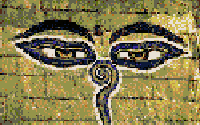
TANTRA
What makes Tantra distinct is that it is a duality, on one hand
a purely philosophic theology, and on the other a metaohysical
practise. Like most esoteric sects, it is culturally symbiotic. It
exists under the guises of local deities and cultural rituals, or
unassuming roadside shrines. In a land where Hindu, Buddhist, and
Islamic faiths collide, often in violence, Tantra exists intact and
sublimated. This is often unconscious, a part of what is available
should someone seeking the mystic path desire a life of deeper
devotion than the average layperson. For westerners, an education
in theology, even a ministry is available for the asking. So it is
with the Eastern world. One may pursue the life of a Brahmin (Hindu
priest), one may devote themselves to a monastery, or you can seek
out one of the mad living Tantric saints, the guru, and question them
about the alternatives.
What we are discussing here is very basic theory and
terminology, and believe me it was difficult deciding what to leave
out. Beacause this is written by a westerner, it is approached
somewhat anthropologically, as data which is available for the
study. I could not, living in America, begin to guess how the
orthodoxy reacts and treats Tantra, nor for a moment can I believe I
require a master to open my eyes for me. Undoubtedly, this may
change - all in good time. One positive note, which has made Tantra
seem all the more approachable to me, is the subject of human
condition. The famous Hindu caste system is, formally, illegal.
Nevertheless it is unlikely that a lower cast individual is allowed
success pursuing the Brahminic path. One element Tantra has long
been noted for, well into the past of the caste system, is that
anyone is permitted to participate, no matter the caste, and that
any person is permitted entrance into a Tantric circle of practice
[chakra].